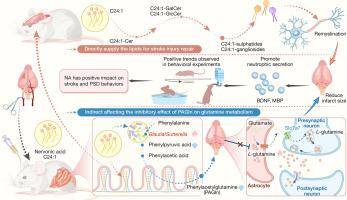Nervonic acid alleviates stroke and its associated poststroke depression behaviors
引用次数: 0
Abstract
Nervonic acid (NA) is an important long-chain monounsaturated fatty acid found in mammalian nervous tissue. It has recently garnered research attention due to its therapeutic potential in treating psychiatric and neurodegenerative disorders. In this study, we investigated the efficacy of NA in treating ischemia/reperfusion and poststroke events in a rat model. Specifically, there was significant reduction in the infarct area, cell death, and neuronal swelling after NA treatment, and the improvement in cerebral blood flow was also observed on day five after middle cerebral artery occlusion. Moreover, NA treatment led to the upregulation of brain-derived neurotrophic factors and myelin basic protein genes. NA displayed improved effects on depressive-like behavior of rats by three validated assays—the sucrose preference test, open-field test, and forced swim test. Regarding the mechanism of action, direct supplementation of NA in the brain was observed. We also observed the indirect effects of NA on the gut microbiota. Notably, the NA group gradually restored the bacterial diversity and the EGb group exhibited no impact based on observed-out analysis. We found an increase in the abundance of Blautia and Sutterella, which participated in phenylalanine metabolism. The metabolomics of plasma and brain samples revealed a decrease in the levels of phenylalanine-based amino acids, which alleviated the inhibitory effects on glutamine metabolism and promoted the recovery and signaling transmission of neurons after stroke. Altogether, our findings suggest that NA can be a viable treatment option for alleviating stroke and its associated poststroke depressive-like behaviors.

神经酸能缓解中风及其相关的中风后抑郁行为
神经氨酸(NA)是哺乳动物神经组织中一种重要的长链单不饱和脂肪酸。由于其在治疗精神疾病和神经退行性疾病方面的治疗潜力,它最近引起了研究人员的关注。在这项研究中,我们研究了 NA 在大鼠模型中治疗缺血/再灌注和中风后事件的疗效。具体而言,NA治疗后,大鼠脑梗塞面积、细胞死亡和神经元肿胀明显减少,大脑中动脉闭塞后第5天的脑血流量也有所改善。此外,NA还能导致脑源性神经营养因子和髓鞘碱性蛋白基因的上调。通过蔗糖偏好试验、开阔地试验和强迫游泳试验这三种有效试验,NA对大鼠的抑郁样行为有改善作用。在作用机制方面,我们观察到了NA对大脑的直接补充作用。我们还观察到了NA对肠道微生物群的间接影响。值得注意的是,根据观察结果分析,NA组逐渐恢复了细菌多样性,而EGb组则没有表现出任何影响。我们发现参与苯丙氨酸代谢的 Blautia 和 Sutterella 的数量有所增加。血浆和脑样本的代谢组学研究显示,苯丙氨酸类氨基酸的水平有所下降,这减轻了对谷氨酰胺代谢的抑制作用,促进了中风后神经元的恢复和信号传递。总之,我们的研究结果表明,NA可作为一种可行的治疗方案,用于缓解中风及其相关的中风后抑郁样行为。
本文章由计算机程序翻译,如有差异,请以英文原文为准。
求助全文
约1分钟内获得全文
求助全文

 求助内容:
求助内容: 应助结果提醒方式:
应助结果提醒方式:


